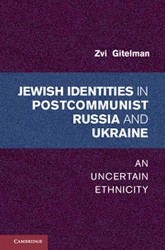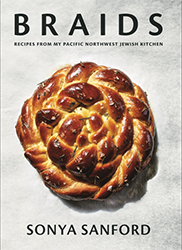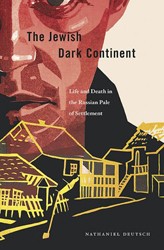Three recent books attempt to demythologize the nostalgia associated with the shtetl. From Sholem Aleichem to Marc Chagall to the Broadway musical Fiddler on the Roof (though Tevye did not live in a shtetl, he lived in a village), writers and artists have depicted the shtetl as idyllic and falsely idealized pre-Holocaust world of Eastern European Jewry. The reality of shtetl life, by contrast, included grinding poverty— but also the opportunity for Jews to participate in trade and commerce, to practice their Judaism, and, despite anti-Semitism, often to engage with their Christian neighbors.
Veidlinger’s In the Shadow of the Shtetl argues that the historic shtetl has been supplanted by an imagined space, a nostalgia that has replaced the essence of authentic shtetl Jewish life. He blames this on early scholarship that characterized the shtetl as one big happy extended family. Most scholars, Veidlinger notes, now recognize that the shtetl has entered public consciousness not as an historical or sociological entity, but rather as an imagined construct based on literary descriptions.
Jeffrey Shandler’s Shtetl: A Vernacular Intellectual History traces how the trajectory of the Yiddish word for “town’ emerged as the key word in Jewish cultural studies. Shandler, a professor of Jewish Studies at Rutgers University, and the author of a number of books on contemporary Jewish culture, describes how Jewish life in provincial towns in Eastern Europe became the subject of extensive creativity, memory, and scholarship, from the early modern era in European history to the present. He contends that in the aftermath of the Holocaust, intellectual engagement with the shtetl emerged not only in scholarship and nonfiction writing but also in an array of other cultural forms: fiction, poetry, films, musicals, and visual art. But Shandler notes that there is no consensus, scholarly or otherwise, on a definition of what constituted a shtetl in terms of its size, location, or proximity to urban centers.
Shandler states that shtetl Jews were socially situated between the nobility and the peasantry before World War I, existing somewhere between subjection and autonomy, and he argues that the shtetl’s contingent intermediary status should be seen as its core feature and the key to understanding the shtetl’s ongoing value as the center of Yiddish vernacularity. Shandler concludes that the meaning of the term shtetl references not just any town but a prewar East European Community. The shtetl has acquired, he states, a greater significance in our time as a substitute for a bygone way of life and for values such as communality, piety, rootedness, and “authentic” Yiddishkeyt.
Yohanan Petrovsky-Shtern, the Crown Family Professor of Jewish Studies at Northwestern University, argues in The Golden Age Shtetl that from the 1790s, when Poland was divided among the Austrian Empire, Prussia, and Czarist Russia, to the 1840s, the shtetl was a thriving community as vibrant as any in Europe. In describing this golden age of shtetl history, the author draws on newly discovered archival material to bring to life dozens of shtetls in Eastern Europe. Contemporary scholarship readily calls any locality in Eastern Europe where Jews resided a shtetl, but Jews some two hundred years ago lived in towns, villages, and cities. Petrovsky-Shtern asserts that the shtetl therefore absorbed various meanings and the tensions between them: the Polish legal and economic private town, the Russian administrative mestechko, and the religious Jewish community. A combination of Czarist political oppression and Russia’s turn to industrialization after 1840 lent a severe blow to the shtetl economy, turning it into “a clumsy town surrounded by beautiful landscapes… with which Jews had little in common.” Petrovsky-Shtern notes that the shtetl’s decline into poverty took almost another fifty years, by which time the Russian regime managed to create robust economies that suppressed the shtetl marketplace.
Although Petrovsky-Shtern’s book devotes chapters to describing life in the shtetl during its ‘golden age,’ he nevertheless concludes that “after all, ‘shtetl’ as a word is nothing but a cultural artifact, a caprice of collective memory. It signifies a vanished Jewish Atlantis, a yearning for a distant and utopian national culture and for the redeeming values of East European Jerusalem… which we tend to strip of its corporeality and then sugarcoat its imaginary residue.”
In the Shadow of the Shtetl, Jeffrey Veidlinger’s indispensable oral history of the shtetls in the Ukraine under Soviet rule and the destructive aftermath during the Nazi invasion of Russia in June 1941, reveals how Jews maintained their religion and traditions under Communism and later coped with the murderous Einsaztgruppen. In telling this story, Veidlinger relies on the recollections of some 400 Ukrainian Jewish returnees on the history of Jewish life in the prewar shtetl, their survival during the Holocaust, and their experiences following the war. The survivors interviewed did not view their wartime experiences within the context of the Holocaust as it is written about in the West: these survivors did not experience deportations in sealed railway cars, death camps, or murder by gassing, and express no distinction between what historians now call the “Holocaust by bullets” and earlier pogroms.
Veidlinger compares the manner in which shtetl nostalgia is presented in the West with the reality of shtetl life in Ukraine where, despite anti-Semitism, Jews constantly interacted with the non-Jewish communities, from Christian peasants to gentile officials. Shtetl, The Golden Age Shtetl, and In the Shadow of the Shtetl constitute a necessary corrective to the picture of everyday shtetl life as presented in our literary culture.
Related Content:





